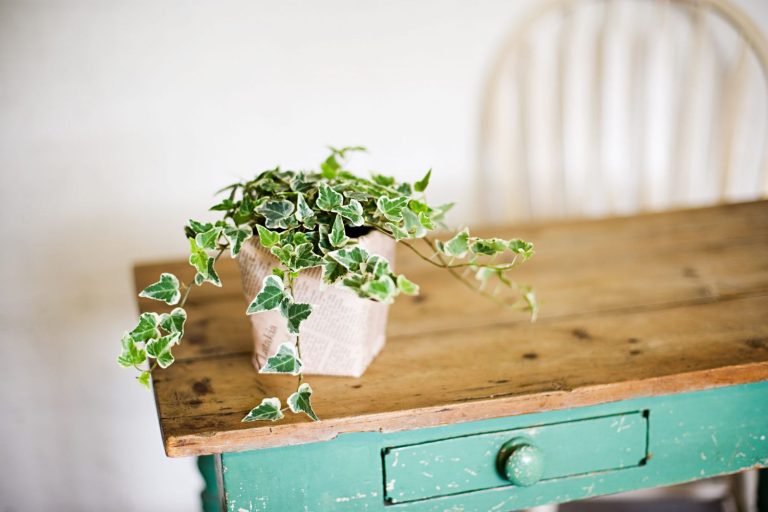Although ivy is often thought of as thriving outdoors, climbing brick walls, spilling over fences, and crawling along the ground, it is also popular as a houseplant and will thrive indoors with the right care. Most ivy species are easy to care for, but there are a few tips to help them grow best. They are easy to propagate and don't require much care, meaning they are a good houseplant. Their leaf shapes and colors range from dark green to silvery to mottled. They can be planted indoors at any time. Some species are very fast, growing several feet a year. Here are some tips on how to successfully grow ivy plants indoors and some varieties to consider. Keep in mind that all parts of English ivy are poisonous to people, dogs, cats, and horses.
Brendan Maher/Getty Images
Caring for indoor ivy plants
Ivy species are both climbing and ground cover plants. Both thrive in shade and tolerate partial sun with moderate to regular watering. When grown indoors, the growing conditions are nearly the same. Outside, they grow and spread quickly, while indoors, their attractive growth spills out of containers and hanging baskets.
Light
Indoors, ivy does best in bright, indirect light: too much shade will make the plant stand out, while too much direct sunlight will burn the leaves.
soil
Ivy grows best when planted in loose, well-drained houseplant soil. Use a pot with plenty of drainage holes.
water
Most ivy varieties need moderate moisture and don't like to be waterlogged, so be sure to allow the soil to dry between waterings. Generally, you should water them once a week in spring and summer, and less frequently in winter.
Temperature and Humidity
Generally speaking, ivy thrives in a moist environment, with moderate temperatures being ideal.
fertilizer
Don't fertilize too frequently — it's usually best to fertilize ivy once a month during warmer seasons.
Image Source/Getty Images
Types of ivy to grow indoors
There are many types of ivy that can be grown indoors. Here are some examples:
Algerian Ivy (Hedera canariensis): Grown as a houseplant, this ivy grows quickly and requires frequent pruning. The leaves are glossy and many varieties are variegated. Needlepoint English Ivy (Hedera helix 'Needlepoint'): Dark green leaves have three to five sharply pointed lobes. Glacier English Ivy (Hedera helix 'Glacier'): Deeply pointed gray-green leaves have creamy white edges. Gold Dust English Ivy (Hedera helix 'Gold Dust'): Named for its mottled pattern that resembles gold flecks.
pruning
If your vines get too long, you can trim them back to keep them shaped and under control. Use clean scissors to cut long, leggy tendrils just above the leaves to encourage bushy growth.
Propagating ivy indoors
To propagate your plants, you can start a new ivy planting by rooting a cutting in water or soil. If you want beautiful deep green or green-and-cream variegated foliage, start with English ivy (such as 'Gold Dust' or 'Baltica') or Algerian ivy. Here's how:
Use clean pruning shears to cut off a 5-inch section of ivy with several leaf nodes. Remove the bottom leaves and place the cutting directly into water or moist soil. Place the cutting in bright, indirect light. Once roots have developed, transplant the cutting into a pot.
If you love ivy but are worried it will take over your garden, growing it indoors is a good way to keep it in check.
Planting and repotting indoor ivy plants
According to The New Southern Living Garden Book, “Ivy is perfect for pots or hanging baskets, where it can be used to create intricate patterns on walls or planted in wire frames to create topiaries. Its tree-like form makes a wonderful accent for foundation plantings and shade gardens.” Hanging baskets allow ivy vines to spill out the sides, giving it plenty of room to grow. They are also easy to hang near a window to give ivy the indirect light it needs. To start your ivy planting, all-purpose or potting soil for indoor plants is sufficient. If the plant becomes root-bound and the pot continues to dry out quickly, repot it about every 2 to 3 years. Use a pot that is 1 to 2 inches larger than the previous pot and has adequate drainage holes. Fill with new potting soil, add the ivy, and water.
Common pests
Although indoor ivy doesn't suffer from many plant diseases, the houseplant is still susceptible to pests such as mealybugs, mites, aphids, whiteflies, and scale insects. In addition, termites can use ivy as an entry point into your home. To get rid of pests, wash the leaves regularly. For recurring problems, you can use neem oil or a horticultural spray.
Common problems with indoor ivy plants
Be aware of the following problems that can occur when growing ivy indoors:
Leaves turn brown
Ivy grown indoors can develop root rot. If the leaves turn brown, the plant may be getting too much water. Make sure the soil is well-drained and avoid overwatering.
Leaves turn yellow
If your ivy's leaves are turning yellow, it's getting too much sun. Move it out of direct sunlight and into a spot that gets morning sun.
What's your favorite easy-to-care-for houseplant? Do you have potted ivy in your home?
FAQ
Do indoor ivy plants prefer direct sunlight?
Indoor ivy needs bright light to grow, but not direct sunlight. Without enough artificial light, ivy will not develop variegation and will grow slowly. Ivy needs room temperatures to stay around 50°F to 70°F during the day.
Should I spray indoor ivy with water?
Indoor ivy doesn't like humidity but will appreciate an occasional mist of water, especially when the air is dry.
What is the fastest growing ivy plant indoors?
Pothos, or Devil's Ivy (Epipremnum aureum), is a fast-growing indoor ivy that can grow over 40 inches each year. This plant is relatively low-maintenance and easy to grow. Pothos prefers shady locations, making it a great houseplant.

